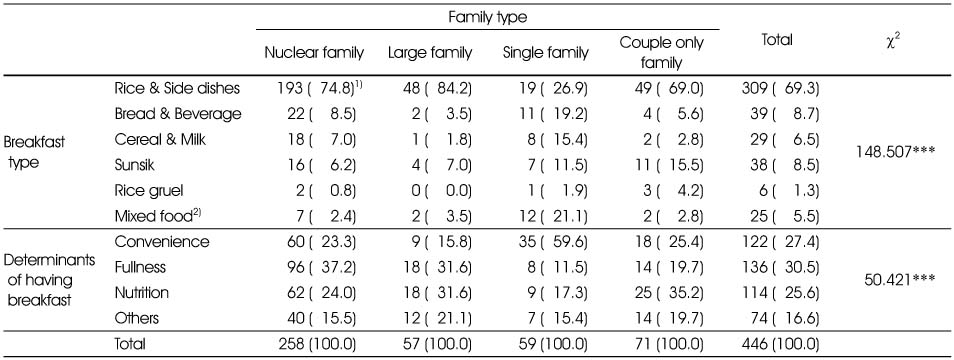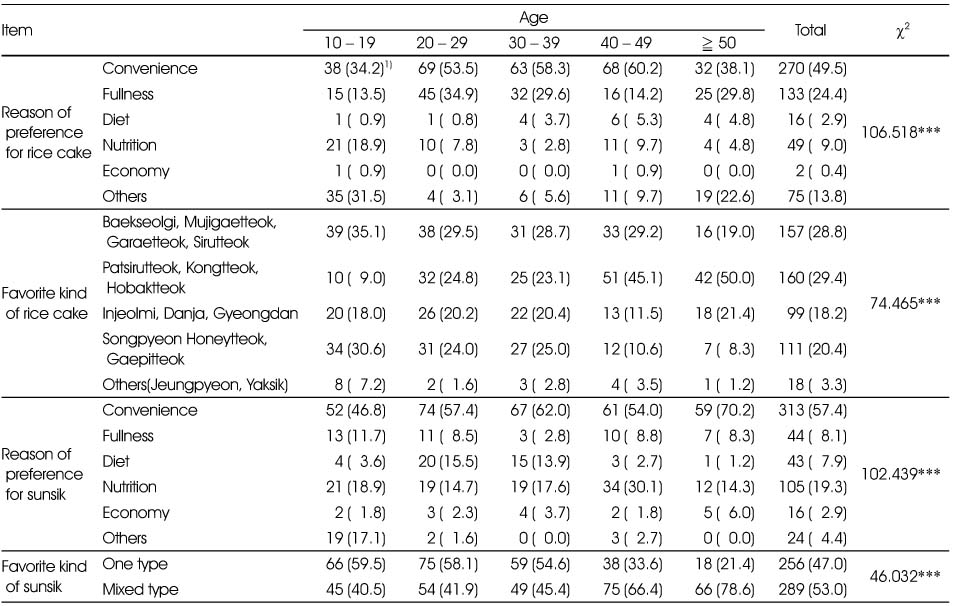Articles
- Page Path
- HOME > Korean J Community Nutr > Volume 16(5); 2011 > Article
-
Original Article
- A Study on the Intakes and Perceptions of Convenient Breakfast
- Yeon-Seo Mun, Eun-Kyung Jung, Nami Joo, Ji-Young Yoon
-
Korean Journal of Community Nutrition 2011;16(5):559-568.
DOI: https://doi.org/10.5720/kjcn.2011.16.5.559
Published online: October 31, 2011
Nutrition Education Graduate School, Sookmyung Women's University, Seoul, Korea.
1Department of Food & Nutrition, Sookmyung Women's University, Seoul, Korea.
2Department of Le Cordon Bleu Hospitality Management, Division of Culture and Tourism, Sookmyung Women's University, Seoul, Korea.
- Corresponding author: Ji-Young Yoon, Department of Le Cordon Bleu Hospitality Management, Division of Culture and Tourism, Sookmyung Women's University, Hyochangwon-gil 52, Youngsan-gu, Seoul 140-742, Korea. Tel: (02) 2077-7372, Fax: (02) 2077-7319, yjy0823@sm.ac.kr
Copyright © 2011 The Korean Society of Community Nutrition
- 1,261 Views
- 4 Download
- 7 Crossref
Abstract
- The purpose of this study was to investigate the intakes and perceptions of convenient breakfast related to age and family type. The survey included 545 men and women living in Seoul from June to July. Questionnaire items covered their age, gender, family types, breakfast intakes and preference for convenient breakfast menu. As a result, there were significant differences in the number of breakfast intakes per week according to family types; large families recorded the highest frequency in "I have breakfast everyday" and the couple-only families and nuclear families scored relatively high numbers. In terms of the type of breakfast, the first choice was "rice and side dishes" across all the age groups (69.3%). There were differences in the preference of convenient breakfast in "bread", "cereal", "rice cake", "sunsik", and "rice gruel" by different age. The teens exhibited the highest preference of bread (5.63), and cereal (5.53) for breakfast; those who were in their fifties for rice cake (5.42). Both forties and fifties showed the higher preference of sunsik (4.58, 4.76) and rice gruel (5.89, 5.77) than other age groups. As for the preference for convenient breakfast according to family types, single person families displayed the highest preference of bread (5.42) and cereal (5.75). Couple families showed higher preference of rice gruel (5.82) than other family groups. The preference level for "rice cake" was similar among all the family types. As a result, it is suggested that the development of various breakfast menus considering age groups and family types is needed so that modern people can enjoy breakfast in terms of quality and quantity in their busy daily life.
- 1. Cho WK, Park HO, Kim SM. A study on breakfast patterns and preference of elementary school children in Inchon area. Korean J Food Nutr. 2002; 15(1): 50-57.
- 2. Choi MY, Park DY, Rhie SG. Rice preference differences in subjects taking breakfast regularly and skipping breakfast in Kyeonggi-do residence. Korean J Community Nutr. 2003; 8(4): 547-555.
- 3. Chung KJ. Dietary and health behavior of rural residents with the various type of family. 2005; Suwon University; 8-11 Dissertation.
- 4. Han MS. A study on the actual status of use of the home meal replacement (HMR) and the users' satisfaction about it. 2006; Sookmyung Women's University; 72-77 MS thesis.
- 5. Jung BM, Ahn CB, Sung CJ. A study on the status of Kimchi preparation, number of side dish and breakfast type of housewives in th Yosu·Chonnam area. J Korean Home Econ Assoc. 2003; 41(3): 35-43.
- 6. Kim HJ. A study of life style, dietary pattern and nutritional knowledge by body mass index (BMI) of middle school students in Daegu. 2007; Daegu Haany University; 7-11 MS thesis.
- 7. Kim JY. Eating habits according to breakfast skipping and preference breakfast menu of high school students in Seoul area. 2008; Sungshin Women's University; 71-76 MS thesis.
- 8. Kim SK. Children's growth and school performance in relation to breakfast. J Korean Diet Assoc. 1999; 5(2): 215-224.
- 9. Korean's bluesummer 6 requiring companies' attention in 2007. Korean National Statistical Office. cited 2010 June 1. Available from http://kostat.go.kr/portal/korea/kor_nw/2/14/1/index.board?bmode=read&aSeq=49823.
- 10. Lee BS, Yang IS. An exploratory study for identifying factors related to breakfast in elementary, middle and high school students. Korean J Community Nutr. 2006; 11(1): 25-38.
- 11. Lee JS, Chung HJ. A study of female college students' breakfast behavior and ideal breakfast type. Korean J Food Cult. 2001; 16(4): 378-387.
- 12. Lee JS. A study of female college students' behavior and ideal breakfast Type-II. dining-out behavior of breakfast and preference on breakfast menu-. Korean J Food Cult. 2003; 18(5): 466-474.
- 13. Lee SH, Shim JS, Kim JY, Moon HA. The effect of breakfast regularity on eating habits, nutritional and health status in adults. Korean J Nutr. 1996; 29(5): 533-546.
- 14. Nam HW, Pyun JW, Hyun YH. Perception and preference of Korean gruel among housewives. Korean J Food Nutr. 2009; 22(3): 463-469.
- 15. Nam SM. The relationship between the eating habits of elementary school students and parenting behavior characteristics. Korean J Food Cult. 2003; 18(6): 515-526.
- 16. Nicklas TA, Reger C, Myers L, O'neil C. Breakfast consumption with and without vitamin-mineral supplement use favorably impacts daily nutrient intake of ninth-grade students. J Adolesc Health. 2000; 27: 314-321.ArticlePubMed
- 17. Oh YM. A study on nutrition knowledge, food behavior, food intake status and recognition with foodservice among Korean middle school students provided with and without national school lunch program. 2003; Sookmyung Women's University; 12-14 MS thesis.
- 18. Park HM. Study on the factors associated with conditions of breakfast intake in elementary school children-in some area of Kyungbuk-. 2005; Yeungnam University; 13-14 MS thesis.
- 19. Shin EY. A study on breakfast of elementary school students in North Gyeonggi area. 2004; Daejin University; 35-45 MS thesis.
- 20. Shin JE, Paik HY, Moon HK, Kim YO. Comparative analysis and evaluation of dietary intakes of Koreans by age group:(1) nutrient intakes. Korean J Nutr. 2001; 34(5): 554-567.
- 21. Yi BS, Yang IS. An exploratory study for identifying factors related to breakfast in elementary, middle and high school students. Korean J Community Nutr. 2006; 11(1): 25-38.
- 22. Yu HH, Nam JE, Kim IS. A study of the nutritional intake and health condition of female college students as related to their frequency of eating breakfast. Korean J Community Nutr. 2003; 8(6): 964-976.
REFERENCES
Figure & Data
REFERENCES
Citations

- Recognition and preference of rice-based home meal replacement for breakfast among adolescents in the Jeonbuk area
Hae-Rim Oh, Hyunsuk Kim, Su-Jin Jung, Youn-Soo Cha
Journal of Nutrition and Health.2021; 54(3): 262. CrossRef - Physical Properties and Sensory Preferences of US Resident-Friendly Sunsik
Mi-Hyun Kim, Jeonghee Surh
Korean Journal of Food and Cookery Science.2018; 34(5): 484. CrossRef - Effect of flour information (origin and organic) and consumer attitude to health and natural product on bread acceptability of Korean consumers
Chung‐Hong Ha, Soh Min Lee, Eun‐Kyung Lee, Kwang‐Ok Kim
Journal of Sensory Studies.2017;[Epub] CrossRef - Study on Breakfast Status and Perception of Substitution Foods for Breakfast in High School Students in Daegu Area
Jae-Hyuk Choi, Geum-Soon Park
Journal of the East Asian Society of Dietary Life.2016; 26(6): 565. CrossRef - A Study on the Consumer Satisfaction, Purchase Behaviors, and Intake Patterns among Domestic Bakery
Kwang Suck Lee, Seung Bum Lee, Hyo Sun Jung
Korean journal of food and cookery science.2015; 31(2): 103. CrossRef - Anti-atherogenic properties of emulsified perilla oil (EPO) in apo E KO mice and plasma lipid lowering effects of rice porridge containing EPO in healthy young adults
Hyejin Jo, Mijeong Kim, Jihyun Lee, Hunjung Kim, Yeong Ok Song
Food Science and Biotechnology.2013; 22(1): 79. CrossRef - Development and Effects' Analysis of Nutrition Education Pamphlet for the Lower Grades Elementary Students -Focused on Individual Daily Needed Food Exchange Units-
Min-Jung Son, Young-Sook Cho, Se-Na Kim, Hye-Ji Seo, Sook-Bae Kim
Korean Journal of Community Nutrition.2011; 16(6): 647. CrossRef
Demographic characteristics of the respondents
1) N (%)
Frequency of breakfast per week according to age
1) N (%), ***: p < 0.001
Frequency of breakfast per week according to family type
1) N (%), ***: p < 0.001
Breakfast type and determinants of having breakfast according to ages
1) N (%)
2) Mixed food means food mixed with rice cake, noodle and beverage
***: p < 0.001
Breakfast type and determinants of having breakfast according to family type
1) N (%)
2) Mixed food means food mixed with rice cake, noodle and beverage
***: p < 0.001
Satisfaction of breakfast type and unsatisfaction reason according to age and family type
1) N (%)
*: p < 0.05 **: p < 0.01 ***: p < 0.001
Preference of convenient breakfast according to age and family type
1) Mean ± SD
2) a-d: Means with letters within a row are significantly different from each other at p < 0.05 by Duncan's multiple range test
**: p < 0.01, ***: p < 0.001
Perception of bread and cereal according to age
1) N (%), ***: P < 0.001
Perception of rice cake and sunsik according to age
1) N (%), ***: P < 0.001
Perception of rice gruel and noodle according to age
1) N (%), ***: P < 0.001
1) N (%)
1) N (%), ***: p < 0.001
1) N (%), ***: p < 0.001
1) N (%) 2) Mixed food means food mixed with rice cake, noodle and beverage ***: p < 0.001
1) N (%) 2) Mixed food means food mixed with rice cake, noodle and beverage ***: p < 0.001
1) N (%) *: p < 0.05 **: p < 0.01 ***: p < 0.001
1) Mean ± SD 2) a-d: Means with letters within a row are significantly different from each other at p < 0.05 by Duncan's multiple range test **: p < 0.01, ***: p < 0.001
1) N (%), ***: P < 0.001
1) N (%), ***: P < 0.001
1) N (%), ***: P < 0.001

 KSCN
KSCN










 Cite
Cite


